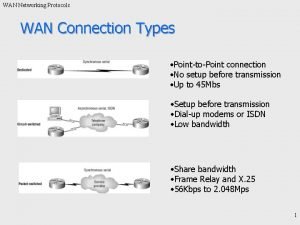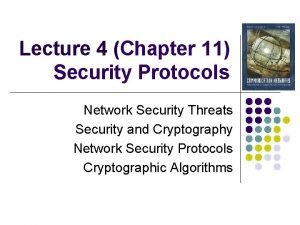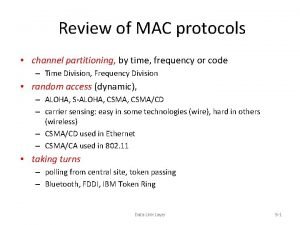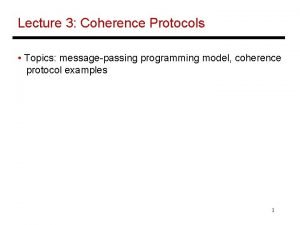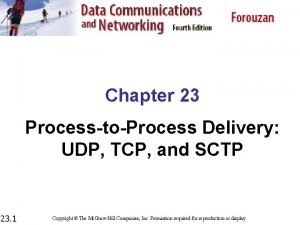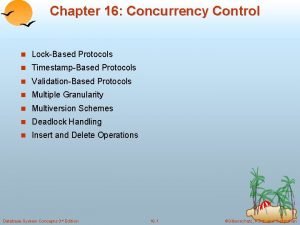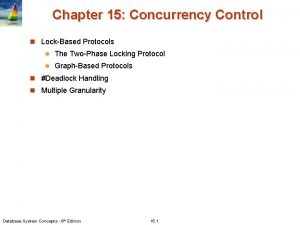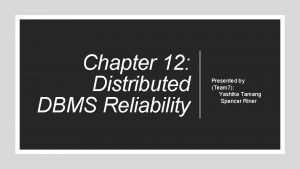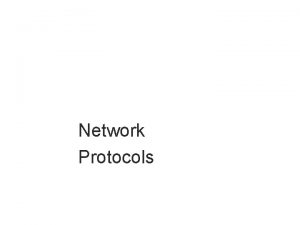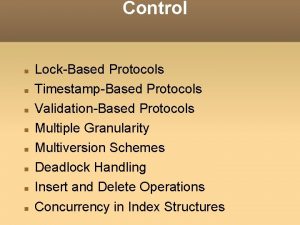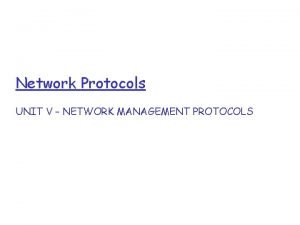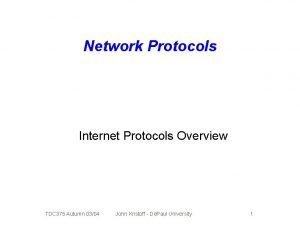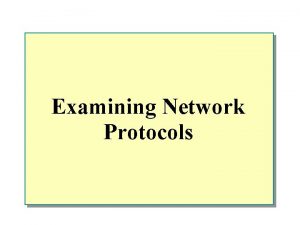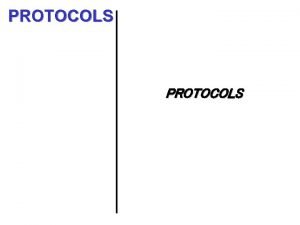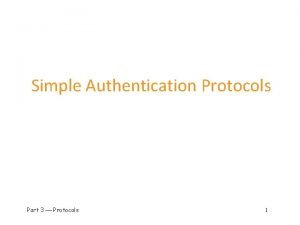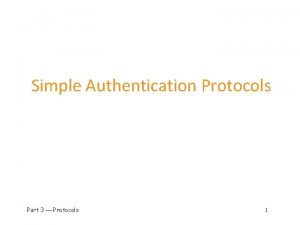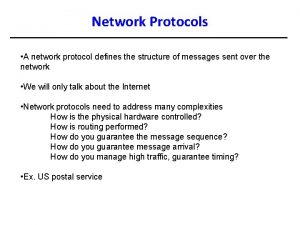Network Overview Protocol Protocol network protocols a special























- Slides: 23

Network Overview

Protocol �Protocol (network protocols) - a special set of rules that define communication between two or more devices on a network.

Port �Port - is best defined as an opening that allows network traffic to pass through. �Here are some examples: Telnet = 23 Sat Telnet (ASA) = 5023 SSH = 22 Sat Telnet(ASA) = 5022 FTP = 21 SFTP = 22 HTTP = 80 HTTPS= 443

Virtualization �Virtualization means creating a software version of something such as operating systems, networks etc. �VLAN - virtually separates a network. �VM - is a self contained operating environment that behaves like a separate computer.

Telnet versus SSH �Telnet - (port 23) - allows a user to remotely access another computer. �SSH (Secure Socket Shell) - (port 22) - a secure way of accessing a computer remotely.

FTP versus SFTP �FTP – (port 21) - a protocol that allow file transfers between computers. �SFTP – (port 22) - a secure protocol that allows file transfers between computers. �TFTP – (port 69) - ( Trivial File Transfer Protocol) a connectionless form of file transfer, which allows files to transfer quicker.

HTTP versus HTTPS �HTTP (Hypertext Transfer Protocol) (port 80) - a protocol for transferring files over the web. �HTTPS (HTTP Secure) - (port 443) secure communication over the network.

Server versus Gateway Server - a computer that provides resources to clients on the network. Gateway – a computer or software that connects network environments so that communication can occur. Media gateway - protocol converter that allows devices running PSTN protocols to communicate with devices on the Internet.

Router versus Switch Router - a device that routes packets through the network. Switch - a device that forwards frames.

Patch, Firmware and Software �Patch - software that fixes issues in a program or operating system. �Firmware - software program or a set of instructions on a device. �Software - programs used to operate the system.

DNS Domain Name System - (port 53) - a protocol that translates domain names into IP addresses. Here is an example of how to identify a website’s IP address: � Traceroute has started… � traceroute: Warning: www. google. com has multiple addresses; using 63. 117. 14. 152 traceroute to www. google. com (63. 117. 14. 152), 64 hops max, 72 byte packets 1 wireless_broadband_router (192. 168. 1. 1) 2. 551 ms 1. 013 ms 4. 988 ms 2 lo 0 -100. nycmny-vfttp-381. verizon-gni. net (100. 37. 197. 1) 5. 692 ms 6. 386 ms 6. 122 ms 3 t 1 -10 -0 -12. nycmny-lcr-22. verizon-gni. net (130. 81. 16. 230) 11. 696 ms 13. 116 ms 11. 415 ms 4 *** 5 *** 6 0. ae 2. gw 2. ewr 19. alter. net (140. 222. 233. 91) 8. 984 ms 10. 457 ms 9. 418 ms 7 google-gw. customer. alter. net (63. 65. 164. 82) 8. 979 ms 13. 826 ms 12. 993 ms 8 152. 14. 117. 63. piscataway. google-ggc. verizon. com (63. 117. 14. 152) 11. 883 ms 11. 669 ms 12. 244 ms � � � � �

DHCP versus Static IP address DHCP (Dynamic Host Configuration Protocol) - (port 67) - is a network protocol that enables a server to assign IP addresses. Static IP address - allows you to assign an IP address to a device.

Ping Utility Ping - a software utility to test a reachable host on an Internet network. PING 192. 168. 1. 3 (192. 168. 1. 3): 56 data bytes 64 bytes from 192. 168. 1. 3: icmp_seq=0 ttl=64 time=0. 063 ms 64 bytes from 192. 168. 1. 3: icmp_seq=1 ttl=64 time=0. 121 ms 64 bytes from 192. 168. 1. 3: icmp_seq=2 ttl=64 time=0. 071 ms 64 bytes from 192. 168. 1. 3: icmp_seq=3 ttl=64 time=0. 169 ms 64 bytes from 192. 168. 1. 3: icmp_seq=4 ttl=64 time=0. 069 ms --- 192. 168. 1. 3 ping statistics --4 packets transmitted, 11 packets received, 0. 0% packet loss

IP Address �IP address – is used by the Internet Protocol that identifies devices on the network. �IPV 4 - a 32 bit number that is represented in a four part number (192. 168. 3. 1). �IPV 6 - a 128 -bit addressing scheme. 3 FFE: 0 B 00: 0800: 0002: 0000: 000 C

Public Versus Private �Public IP address- is on the Public Internet whatismyip. com �Private IP address- is on a Private Intranet

IPV 4

IPV 4

IPv 4

IPv 4 - Private Address Default Subnet Mask Class A 10. 0 – 10. 255. 0. 0. 0 Class B 172. 16. 0. 0 – 172. 31. 255 255. 0. 0 Class C 192. 168. 0. 0 – 192. 168. 255 255. 0

IPv 4 - Class C Classless Inter. Domain Routing (CIDR) notation Subnet Mask /24 255. 0 /25 255. 12 8 /26 Network s IP address Host per network 256 254 2 128 126 255. 19 2 4 64 62 /27 255. 22 4 8 32 30 /28 255. 24 0 16 16 14 /29 255. 24 8 32 8 6

IPv 4 /24 Number of Networks Network ID Host Range Broadcast 1 192. 168. 1. 0 192. 168. 1. 1 192. 168. 1. 25 – 5 192. 168. 1. 25 4 Number of Network ID Host Range 1 192. 168. 1. 0 192. 168. 1. 12 – 7 192. 168. 1. 12 6 2 192. 168. 1. 12 192. 168. 1. 25 8 9 5 192. 168. 1. 25 /25 Broadcast

IPv 4 /26 Network ID Range of Host Broadcast 1 192. 168. 1. 0 192. 168. 1. 1 – 192. 168. 1. 6 2 192. 168. 1. 6 3 2 192. 168. 1. 6 4 192. 168. 1. 6 5192. 168. 1. 1 26 192. 168. 1. 1 27 3 192. 168. 1. 1 28 192. 168. 1. 1 29 – 192. 168. 1. 1 90 192. 168. 1. 1 91 4 192. 168. 1. 1 92 192. 168. 1. 1 93192. 168. 1. 2 54 192. 168. 1. 2 55

IPv 4 /27 Network ID Range of Host Broadcast 1 192. 168. 1. 0 192. 168. 1. 1192. 168. 1. 30 192. 168. 1. 31 2 192. 168. 1. 33192. 168. 1. 63 3 192. 168. 1. 64 192. 168. 1. 65192. 168. 1. 94 192. 168. 1. 95 4 192. 168. 1. 96 192. 168. 1. 97 – 192. 168. 1. 126 192. 168. 1. 127 5 192. 168. 1. 128 192. 168. 1. 129192. 168. 1. 158 192. 168. 1. 159 6 192. 168. 1. 160 192. 168. 1. 161192. 168. 1. 190 192. 168. 1. 191 7 192. 168. 1. 193 192. 168. 1. 222 192. 168. 1. 223 8 192. 168. 1. 224 192. 168. 1. 225192. 168. 1. 254 192. 168. 1. 255
 Network protocols map
Network protocols map Network security protocols
Network security protocols Network security protocols
Network security protocols Wireless sensor network protocols
Wireless sensor network protocols Whats my ip
Whats my ip Network communication protocols map
Network communication protocols map Chapter 3 network protocols and communications
Chapter 3 network protocols and communications Gsm network overview
Gsm network overview Data link
Data link Channel partitioning mac protocols
Channel partitioning mac protocols Proofs of work and bread pudding protocols
Proofs of work and bread pudding protocols Presentation layer
Presentation layer Lgs pms
Lgs pms Cache coherence protocols
Cache coherence protocols Wan protocols and technologies
Wan protocols and technologies Define nursing protocols
Define nursing protocols Communication protocols for rpc
Communication protocols for rpc Cryptography standards and protocols
Cryptography standards and protocols What are two pitfalls (problems) of lock-based protocols
What are two pitfalls (problems) of lock-based protocols Tcp and sctp are both layer protocols
Tcp and sctp are both layer protocols What are two pitfalls (problems) of lock-based protocols
What are two pitfalls (problems) of lock-based protocols What are two pitfalls (problems) of lock-based protocols
What are two pitfalls (problems) of lock-based protocols Session layer functions
Session layer functions Reliability concepts and measures in distributed database
Reliability concepts and measures in distributed database
